Author and architecture expert Philip Wilkinson of the English Buildings Blog begins the first in a new mini series, exploring the lives and works of some mid-century illustrators who seem to have slipped unjustly from view. We begin with children’s author Helen Carstairs…
The phone rings. It is the Resident Wise Woman, calling me from a charity shop to ask about a
book she has spotted. The line is terrible and our call is cut short, and cut short again when she
calls back, but she wants to know if we have Looking Round London by Helen Carstairs. We do
not. A while later she returns, clutching the most delightful children’s book I’ve seen in a long time,
and one, what’s more, that I didn’t know existed. I am more and more fascinated as I turn the pages.
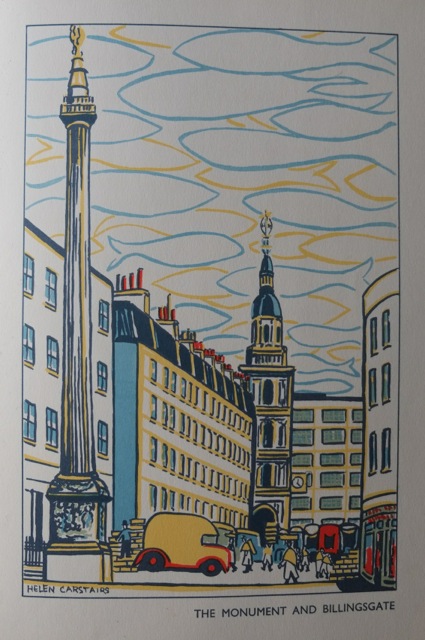
Looking Round London bears no date of publication, but internal evidence suggests that it came
out in around 1938. It contains 22 full-page illustrations depicting the ‘sights’ of London – the great
churches, the royal parks, the British Museum, the Houses of Parliament, Covent Garden market,
and so on. Most of them are brightly coloured and packed with human activity – people feeding the
birds, sailing in Regent’s Park, riding in Hyde Park, porters at Covent Garden and Billingsgate.
There’s a lovely, free colourful line that sometimes seems to have a touch of Lowry, sometimes
even of Matisse. And there’s a bit of whimsy, too, not overdone but very much there, in the form of
lines like radio waves above Broadcasting House and fish-shaped clouds (“very like a whale”)
above Billingsgate.
Among my favourites is one showing the Tower of London with children playing on the sandy
beach that there used to be by the river. The figures, the colourful trees, the wavy lines in the sky
and on the river are all aspects of it that catch my eye. But most of all I’m affected by what’s behind
this sunny illustration – that it catches a London that, already, as the presses were rolling, had the
clouds of a gathering storm approaching it, and that, in a few years more, would be blitzed.
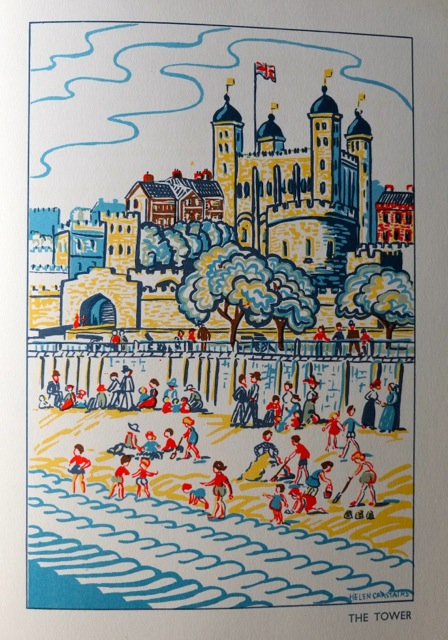
I get the same feeling from Helen Carstairs’ illustration of St James’s Park, with Buckingham
Palace in the background and pelicans at the front. The trees, bustling people, and those
characterful pelicans make for an engaging image, and I especially like the details caught in a few
strokes – those old-fashioned perambulators and the Royal Standard flying above the palace.
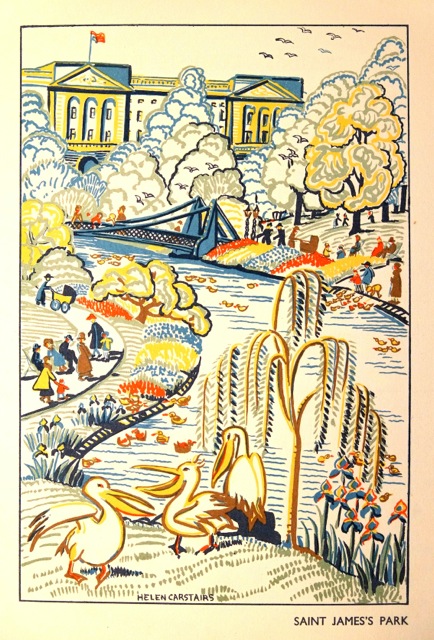
St James’s Palace is less well known but even more vivid in the Carstairs version. The building’s
bricks are a vibrant red; the brickwork is depicted as a stylised grid – unrealistic but effective, and
one of the features of these pictures that reminds me of needlework. Still brighter are some of the
coats on the figures in the foreground, figures, again, that are delineated, hats and all, with just a
few brushstrokes. The Monument and Billingsgate, and the Houses of Parliament, are just as
engaging and lively, what with the boat lowering its funnel to pass under Westminster Bridge and
the Billingsgate porters and vans – not to mention the appropriately fishy sky.
It’s so moving, this sunny pre-war book, in which so many people have time for leisure and the
freedom to enjoy the outdoor city. Its illustrations truly come to us from another age. There’s
another way in which this book seems distant from us. We know (or I know, at any rate) virtually
nothing about its author-illustrator. Who was Helen Carstairs? Reference books and the internet tell
us very little: that she was around in c. 1938 and published Looking Round London. No other
books seem to be credited to her. Yet she was on to something with her winning illustrations. Did
she give up and do something else? Did she survive the war? Does anyone know more?

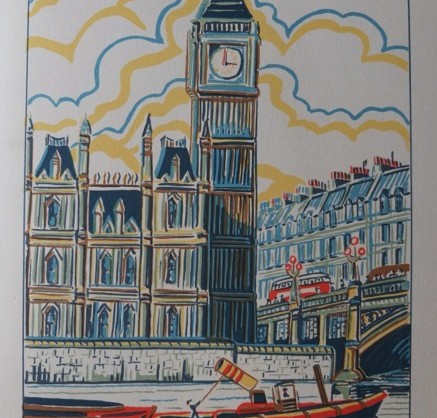
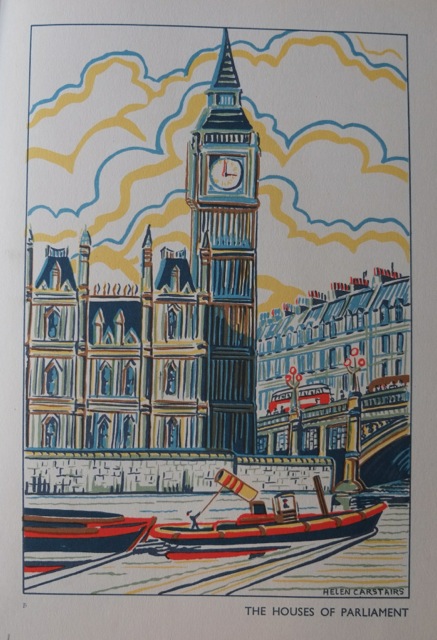
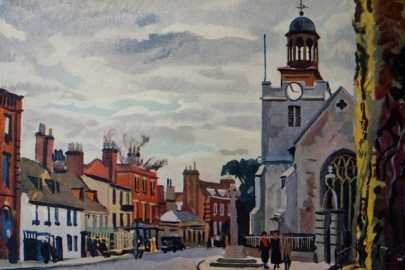







Wonderful stuff – what a find!
I love that picture of the Tower – a day at the seaside in the middle of London. If someone can turn these into posters they’d sell like hot cakes.
Or tea towels! They seem quite like fabric designs. Fantastic images
Worm: Yes, they are rather like fabric designs. Tea towels would be brilliant (not a sentence I would have imagined myself writing). The paper in my copy has yellowed (on some pages more than others): it would be wonderful to be able to see the original artwork, and to reproduce new prints from it, but no doubt it has long perished.
The paintings of John Paddy Carstairs have some similarities: lot of cityscapes from a similar perspective employing bright colours and repeated shapes, though in a much freer hand. Are they the same person?
https://www.google.co.uk/search?q=john+paddy+carstairs+paintings&client=safari&rls=en&tbm=isch&tbo=u&source=univ&sa=X&ei=ma1NVebDCO2p7AbotYGwBg&ved=0CCcQsAQ&biw=1393&bih=699
Who knows? There are similarities, and aliases do not seem to have been a problem for John Paddy. To my eyes, though, the differences are significant. Helen seems to have an ability to say it all with coloured line that I don’t find in John Paddy. So I wouldn’t have thought these pictures were by the same person, but that’s just my subjective judgement.
Incidentally, how common is it for people to adopt aliases? Keeping to the same gender, or adopting ambiguous initials, seems the norm, but I expect there are plenty of exceptions. Martin Ross (half of the female duo Somerville and Ross) and Michael Field (one male name adopted by two women writing collaboratively) are two notable examples. Men calling themselves women? Rarer still, I\’d have thought.
That last comment of mine got garbled somehow. The question I meant to ask at the beginning of the second paragraph was how common is it for men to adopt a female alias, or women to adopt a male one.
Helen (Kininmonth) Carstairs (1887-1956) was my grandmother. She was the fourth daughter of James Leonard Kininmonth (1832-1896) and Euphemia Carstairs (1855-1903) who emigrated from Fife to Australia. When her father died her mother brought the whole family back to Scotland. They lived in Fife and in Edinburgh where Helen went to school. In 1903 her mother died of cancer and in 1906 it was decided that the young Kininmonths should return to Australia.
In 1910 Helen married her first cousin, James Carstairs (1882-1965), in Buenos Aires. They had 3 sons. From March 1920 the family lived in Paris for 12 months during which both James and Helen attended art school. (Helen had studied art for a few months in Paris in 1906 before leaving for Australia.)
Helen’s great love was painting with water colours and oil paints, with excursions into embroidery. Painting seemed to come easily to her but she would become totally absorbed in the work and dinner was likely to suffer. Another of her passions was gardening and, with a large garden and three boys to bring up, she was always busy. As a result she left all too few pictures behind her.
Looking Round London was her only published work. It was published by Blackie in 1937. I do not know where the original pictures are.
Helen died of cancer in 1956 at the age of 69.
Thanks very much for that James, much appreciated!
I’ll alert Philip.
As someone who has been involved in the business of illustrated books for several decades, I was fascinated to come across a book, so beautifully illustrated, by an artist I\’d not heard of and who had apparently escaped the attention of reference books and online writers. Thank you very much, then, for filling in some of the background about your grandmother, Helen Carstairs. It\’s a shame that she published nothing else, but life takes it turns and we still have the images in Looking Round London, windows into a city that has changed so much since 1937. I cherish my copy of the book and I\’m sure other owners do too.